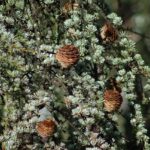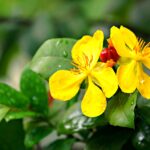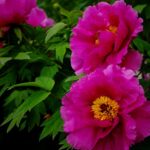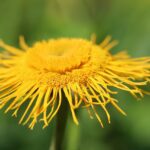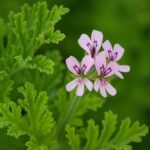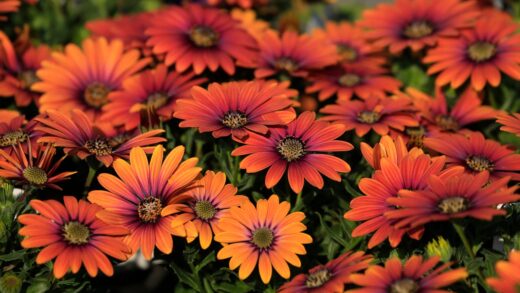One of the most significant advantages of cultivating the bluebeard shrub is its exceptional natural resistance to a wide array of common garden ailments. The plant’s foliage contains aromatic compounds that are not only pleasant to the human senses but also serve as a powerful deterrent to many potential pests, including notoriously destructive browsers like deer and rabbits. This inherent resilience means that Caryopteris is a wonderfully low-maintenance option that rarely requires the use of chemical sprays or other intensive interventions. However, no plant is completely invincible, and understanding the few potential issues that can arise, primarily related to cultural conditions, will empower you to keep your shrub healthy and vibrant for years to come.
The most prevalent and serious health issue that can affect Caryopteris is not caused by a pest or pathogen in the traditional sense, but rather by improper growing conditions. Root rot, typically caused by various soil-borne fungi such as Phytophthora, is a direct consequence of soil that remains waterlogged for extended periods. The roots of the bluebeard are highly sensitive to oversaturation and require well-aerated soil to thrive. When the soil is constantly wet, the roots are deprived of oxygen and begin to decay, creating an entry point for these opportunistic fungi. This is why providing excellent drainage is the single most important factor in maintaining the health of this shrub.
The symptoms of root rot can often be misleading, as they may initially resemble those of drought stress. An affected plant will often exhibit wilting leaves, even when the surrounding soil is moist. The foliage may also turn yellow or pale green, and the overall growth of the plant will be stunted and lack vigor. In advanced stages, the branches may begin to die back, and the entire plant can eventually perish. If you suspect root rot, you can gently excavate around the base of the plant to inspect the roots. Healthy roots should be firm and white or light-colored, whereas rotten roots will be brown, black, soft, and mushy.
Preventing root rot is far more effective than trying to cure it. The primary preventative measure is careful site selection. Choose a planting location that does not have standing water after heavy rain and avoid low-lying areas in the garden. Amending heavy clay soils with copious amounts of organic matter like compost or pine bark before planting is crucial to improve its structure and drainage. For those with persistently heavy or wet soil, planting Caryopteris in a raised bed or on a gentle slope can provide the necessary elevation to keep its roots out of saturated conditions.
Once root rot has taken hold, reversing the damage can be very difficult. The first step is to immediately cease all supplemental watering and allow the soil to dry out as much as possible. For container-grown plants, ensure the pot’s drainage holes are not blocked and that it is not sitting in a saucer of water. In some cases, if the disease is caught early, the plant may recover if its growing conditions are corrected. However, for severely affected plants, removal and replacement may be the only option to prevent the spread of the fungal pathogens in the soil.
More articles on this topic
Managing common insect pests
While Caryopteris is not a primary target for most insect pests, it can occasionally play host to a few common garden dwellers, particularly if the plant is under stress from other factors like drought or poor nutrition. Aphids are one such potential pest. These small, soft-bodied insects typically congregate in clusters on new, tender growth and the undersides of leaves. They feed by piercing the plant tissue and sucking out the sap, which can cause new leaves to become curled, distorted, or yellowed. A heavy infestation can weaken the plant and reduce its vigor.
Fortunately, managing aphids on a resilient shrub like bluebeard is usually straightforward. For minor infestations, a strong jet of water from a garden hose is often sufficient to dislodge the pests from the plant. This method should be repeated every few days until the population is under control. Encouraging natural predators in your garden, such as ladybugs, lacewings, and parasitic wasps, is also a highly effective long-term strategy. These beneficial insects are voracious predators of aphids and can keep their populations in check without any chemical intervention.
In cases of a more persistent or heavy aphid infestation, an application of insecticidal soap or horticultural oil can be very effective. These products work by suffocating the insects on contact and have a low impact on beneficial insects and the wider environment, provided they are used according to the label directions. It is important to ensure thorough coverage, especially on the undersides of the leaves where aphids tend to hide. As with any treatment, it is best to apply it in the early morning or evening to avoid spraying in direct sun, which can cause leaf scorch.
Another pest that may occasionally appear, especially in hot, dry conditions, is the spider mite. These tiny arachnids are difficult to see with the naked eye, but their presence is often indicated by a fine webbing on the leaves and stems, as well as a stippled or speckled appearance on the leaf surfaces. Like aphids, they feed on plant sap, and a severe infestation can cause leaves to turn yellow or bronze and eventually drop off. Increasing the humidity around the plant by hosing it down can help to deter spider mites, and they can also be controlled with insecticidal soap or horticultural oil if necessary.
More articles on this topic
Fungal leaf spots and powdery mildew
Although uncommon, Caryopteris can occasionally be affected by fungal leaf spot diseases. These diseases typically manifest as small, discolored spots on the leaves, which may be brown, black, or tan, and sometimes have a yellow halo around them. As the disease progresses, the spots may enlarge and merge, and in severe cases, can lead to premature leaf drop. These fungal issues are most prevalent during periods of prolonged wet weather, especially when there is poor air circulation around the plant.
The best defense against leaf spot diseases is prevention through good cultural practices. Ensure your Caryopteris is planted in a location that receives full sun and has good air movement. Sunlight and wind help to dry the foliage quickly after rain or irrigation, creating an environment that is less hospitable to fungal spore germination. Proper spacing between plants is also crucial; avoid overcrowding your shrubs to allow air to circulate freely through their branches. When watering, use a soaker hose or drip irrigation to apply water directly to the soil, keeping the foliage as dry as possible.
If you do notice a minor leaf spot infection, it is often not serious enough to warrant treatment and will not significantly harm the health of a mature, well-established plant. You can help to limit the spread of the disease by removing and disposing of the most heavily infected leaves. It is also important to practice good garden sanitation by cleaning up and removing all fallen leaves from around the base of the plant in the autumn. This reduces the amount of fungal inoculum that can overwinter in the garden debris and cause a new infection in the spring.
Powdery mildew is another fungal disease that, while rare on Caryopteris, can appear under certain environmental conditions. It is easily recognizable by the characteristic white, powdery coating that forms on the surface of leaves and stems. It typically thrives in conditions of high humidity, particularly when days are warm and nights are cool. Just as with leaf spots, ensuring good air circulation and keeping the foliage dry are the most effective preventative measures. If treatment is necessary, horticultural oils or specific fungicidal sprays can be effective, but they are rarely needed for this resilient shrub.
Environmental and abiotic stressors
Sometimes, the problems affecting a bluebeard are not caused by a living pest or disease but are instead the result of environmental or abiotic stressors. One of the most common issues is sun scorch, which can occur during periods of intense heat and sunlight, particularly if the plant is also experiencing some degree of drought stress. The symptoms appear as browned, dried-out, or “burnt” patches on the leaves, especially on the parts of the plant most exposed to the direct afternoon sun. Ensuring the plant is adequately watered during heatwaves is the best way to prevent this.
Winter damage is another common abiotic issue, especially for Caryopteris grown in colder climates. The plant may experience dieback of its stems, where the tips or entire branches are killed by frost and cold temperatures. This is a normal occurrence in colder zones and is not a sign of disease. Since Caryopteris blooms on new wood, this winter dieback is easily managed by the routine hard pruning that should be performed in late winter or early spring. This annual pruning removes all the damaged wood and encourages fresh, healthy growth from the base.
Nutrient imbalances, as discussed previously, can also cause symptoms that may be mistaken for disease. An excess of nitrogen, for example, can lead to weak, floppy growth that may be more susceptible to pests. A deficiency in a key nutrient like iron, often caused by an overly alkaline soil pH, can lead to interveinal chlorosis, where the leaves turn yellow, but the veins remain green. A soil test is the best way to diagnose such issues and determine the correct course of action, which might involve adjusting the soil pH or applying specific micronutrient supplements.
Improper pruning can also be a source of stress for the plant. While Caryopteris is very tolerant of a hard prune, making the cuts at the wrong time of year can cause problems. Pruning too late in the autumn, for example, can remove wood that would have provided some winter protection for the crown and may stimulate new growth that is immediately killed by frost. Sticking to the recommended late-winter or early-spring pruning schedule is the best way to ensure this vital maintenance task contributes positively to the plant’s health.
The role of beneficial insects
Creating a garden environment that is welcoming to beneficial insects is one of the most proactive and sustainable strategies for pest management. These “good bugs” are natural predators and parasitoids of many common garden pests, and they provide a free and continuous pest control service. Ladybugs and their larvae, for example, are famous for their voracious appetite for aphids. A single ladybug can consume thousands of aphids in its lifetime. By fostering a healthy population of these allies, you can prevent many potential pest problems before they even begin.
To attract and support beneficial insects, it is important to plant a diverse range of flowering plants in your garden. Many beneficial insects, such as hoverflies and parasitic wasps, feed on nectar and pollen as adults. Providing a continuous supply of blooms from spring through autumn will give them a reliable food source. Plants from the carrot family (Apiaceae), such as dill, fennel, and parsley, and the daisy family (Asteraceae), like cosmos and sunflowers, are particularly effective at attracting these helpful insects.
Reducing or eliminating the use of broad-spectrum chemical pesticides is absolutely essential for protecting beneficial insect populations. These chemicals are indiscriminate and will kill the predators just as readily as they kill the pests. The loss of these natural enemies can lead to a resurgence of pest populations, often in greater numbers than before, creating a cycle of dependency on chemical controls. By adopting integrated pest management (IPM) techniques and using targeted, low-impact solutions like insecticidal soap only when necessary, you can preserve the delicate balance of your garden’s ecosystem.
Providing a source of water and shelter can also help to support beneficial insects. A shallow dish of water with some pebbles or marbles for the insects to land on can be a valuable resource, especially during dry weather. Leaving some areas of the garden a bit “wild” with leaf litter or ornamental grasses can provide overwintering habitat for many of these valuable garden partners. By making your garden a haven for these allies, you not only protect your Caryopteris but also contribute to the overall health and resilience of your entire garden.









